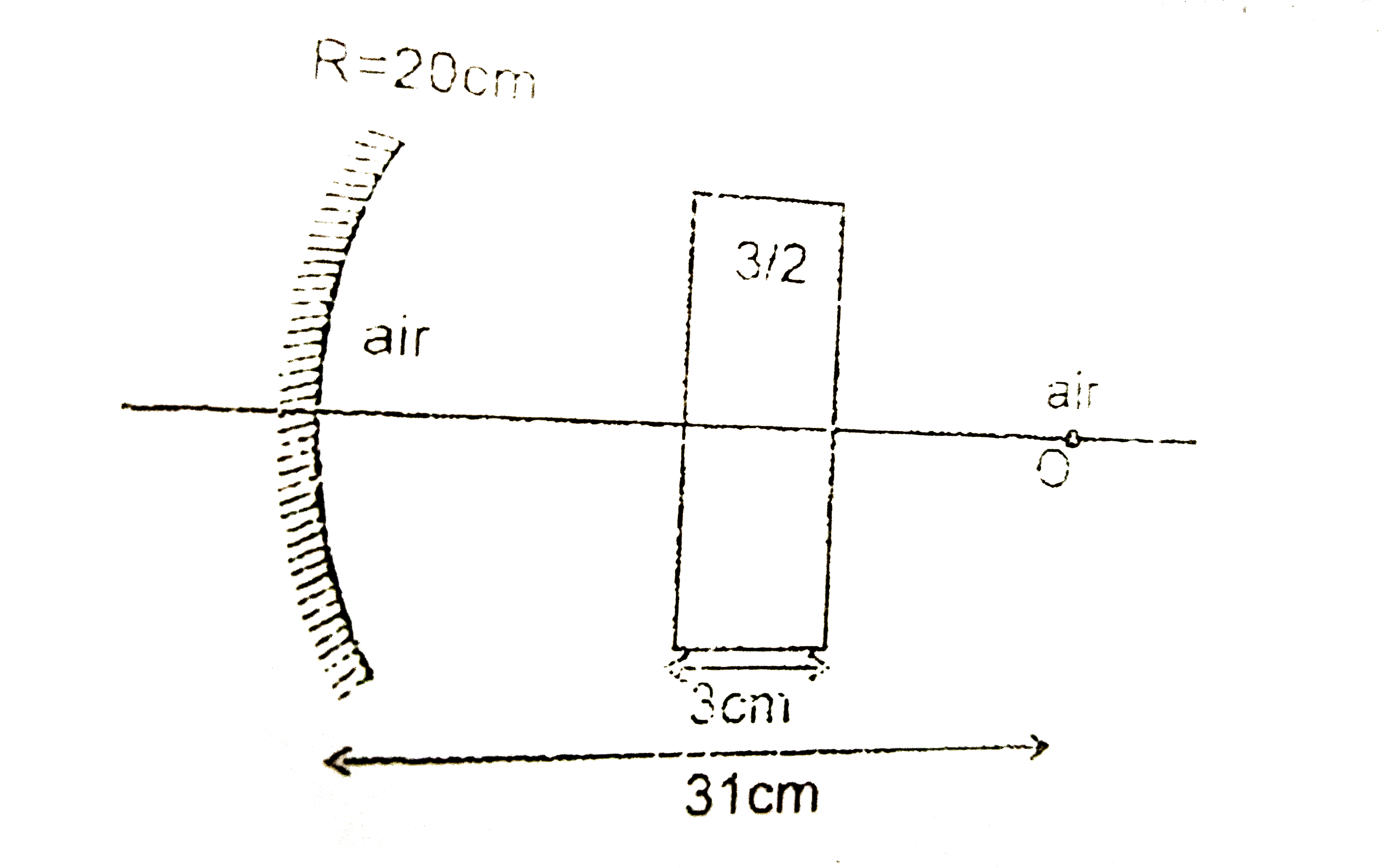An extended object is placed perpendicular to the principal axis of a concave mirror of radius of curvature 20cm at a distance of 15 cm from the pole. Find the lateral magnification produced.
To solve the problem of finding the lateral magnification produced by a concave mirror, we will follow these steps:
Step 1: Identify the given values
- Radius of curvature (R) = 20 cm
- Distance of the object from the pole (u) = -15 cm (the negative sign indicates that the object is in front of the mirror)
Step 2: Calculate the focal length (f)
The focal length (f) of a concave mirror is given by the formula:
f=−R2
Substituting the value of R:
f=−20cm2=−10cm
Step 3: Use the mirror formula to find the image distance (v)
The mirror formula is given by:
1f=1v+1u
Rearranging it to find v:
1v=1f−1u
Substituting the values of f and u:
1v=1−10−1−15
Finding a common denominator (30):
1v=−330+230
1v=−130
Taking the reciprocal to find v:
v=−30cm
Step 4: Calculate the lateral magnification (M)
The lateral magnification (M) is given by the formula:
M=−vu
Substituting the values of v and u:
M=−−30−15
M=−2
Final Answer:
The lateral magnification produced by the concave mirror is -2.
---
- Radius of curvature (R) = 20 cm
- Distance of the object from the pole (u) = -15 cm (the negative sign indicates that the object is in front of the mirror)
The focal length (f) of a concave mirror is given by the formula:
f=−R2
Substituting the value of R:
f=−20cm2=−10cm
The mirror formula is given by:
1f=1v+1u
Rearranging it to find v:
1v=1f−1u
Substituting the values of f and u:
1v=1−10−1−15
Finding a common denominator (30):
1v=−330+230
1v=−130
Taking the reciprocal to find v:
v=−30cm
The lateral magnification (M) is given by the formula:
M=−vu
Substituting the values of v and u:
M=−−30−15
M=−2
The lateral magnification produced by the concave mirror is -2.
Topper's Solved these Questions
- BOOK - CENGAGE PHYSICSCHAPTER - GEOMETRICAL OPTICSEXERCISE - Solved Examples15videos
GEOMETRICAL OPTICS
- BOOK - CENGAGE PHYSICSCHAPTER - GEOMETRICAL OPTICSEXERCISE - Exercise1.114videos
GEOMETRICAL OPTICS
- BOOK - CENGAGE PHYSICSCHAPTER - FRICTIONEXERCISE - QUESTION BANK1videos
FRICTION
- BOOK - CENGAGE PHYSICSCHAPTER - GRAVITATIONEXERCISE - Question Bank39videos
GRAVITATION
Similar Questions
An object is placed in front of a concave mirror of radius of curvature 40cm at a distance of 10cm. Find the position, nature and magnification of the image.
View SolutionA 2.0 cm tall object is placed perpendicular to the principal axis of a concave mirror of focal length 10 cm. The distance of the object from the mirror is 15 cm. Find the nature, position and size of the image formed. Represent the situation with the help of a ray diagram.
View Solution
Knowledge Check
- Question 1 - Select One
An object of height 1cm is kept perpendicular to the principle axis of a convex mirror of radius of curvature 20cm. IF the distance of the object form the mirror is 20cm then the distance (in cm) between heads of the image and the object will be:
A√64049B√64149C403Dnone of these - Question 2 - Select One or More
A real point object is kept on the pricipal axis of a concave mirror (radius of curvature =20cm) at a distance 60 cm from the pole. Take pole as origin and direction of incident light as positive direction of X axis. Y axis is perpendicular to the principal axis. Select correct statement(s).
AIf velocity of object t=1ˆi and velocity of mirror =0 then velocity of image will be −125ˆiBIf velocity of object =1ˆj velocity of mirror =0 then velocity of image will be −15ˆjCif velocity of object =0 and velocity of mirror =1ˆi then velocity of image will be 125ˆiDif velocity of object =0 ad velocity of mirror =1ˆj then velocity of image will be 15ˆj - Question 3 - Select One
A point object is placed at a distance 20 cm from the focus of a concave mirror of radius of curvature 20 cm. Find the distance (in cm) of the image from the focus.
A5 cmB10 cmC15 cmD20 cm
A point object is placed on principal axis of a concave mirror of radius of curvature 20cm at a distance 31cm from poll of the mirror. A glass slab of thikness 3cm and refractive index 1.5 is placed between object and mirror as shown in the figure. Find the distance (in cm) of final image formed by the system from the mirror.
 View Solution
View SolutionA point object is placed at a distance 20 cm from the focus of a concave mirror of radius of curvature 20cm. Find the distance (incm) of the image from the focus.
View SolutionAn object is placed at distance of 12 cm from a concave mirror of radius of curvature 16 cm. Find the position of the image.
View SolutionAn object is placed at 20 cm from the pole of a concave mirror. It forms real image at a distance of 60 cm from the pole. Find the focal length of the concave mirror.
View SolutionA particle moves in a circular path of radius 5 cm in a plane perpendicular to the principla axis of a xonvex mirror with radius of curvature 20cm. The object is 15cm in front of the mirror. Calculate the radius of the circular path of the image.
View Solution
